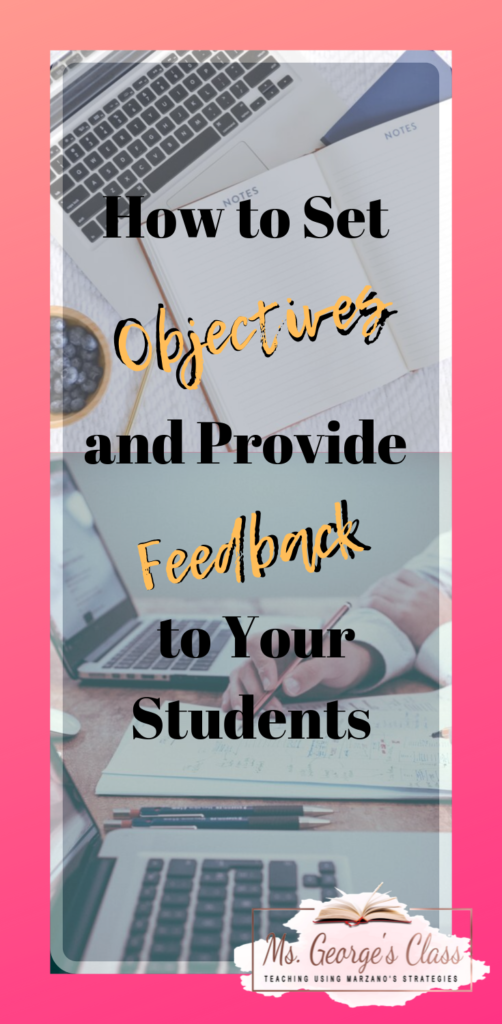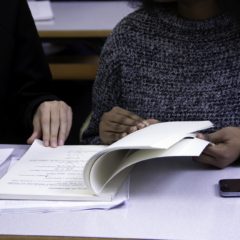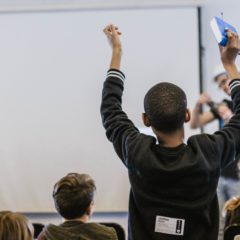
Reflect on your schooling. How did your teacher set objectives for the class? How was feedback given for a specific assignment? A lot has transformed in education over the course of years, and especially throughout the decades. As a teacher, you must be very familiar with objectives within your content area and your learning targets must include performance, conditions, and criterions. Teachers must provide feedback that is corrective, timely, and specific to a standard. Focusing on these two areas will establish a direction for learning and allow students to take ownership of what they are learning.
Goal Setting
According to the book Classroom Instruction that Works: Research-Based Strategies for Increasing Student Achievement, there are three generalizations from goal setting. The generalizations are: 1) “Instructional goals narrow what students focus on” 2) “Instructional goals should not be too specific” 3) “Students should be encouraged to personalize the teacher’s goal” (Marzano et al. 94). When setting learning goals, you want the goals to be narrow enough to meet a criterion, but broad enough for a student to create a personal goal. The example the text used was a science teacher stating, “students will understand how each of the major organs worked individually”. This a goal that is not too broad nor narrow. Students created individual goals using sentence stems from their teacher. One student wrote, “I want to know more about the kidneys and how they work. My grandpa is having a kidney replaced soon…” (Marzano et al. 95). This is a great strategy to use because students are being accountable for their own learning and creating personal instructional goals using the teacher’s unit target.
Contracts

Contracts are a variation of goal setting. For many years, I used contracts with my students to study vocabulary, keep a binder, and complete homework assignments. It was a formal contract and I met with each student where they would set goals and sign the contract. The contract ended at parent-teacher conference. At parent-teacher conference, they were to present their binders and demonstrate to their parent their learning. Students appeared to be engaged in the contracts, but as a teacher it was overwhelming. I had 170 students each year and I had to plan individual weekly meetings. For the last few years, I have taught nearly 100 students. That is more manageable, and I am considering returning the contract.
Feedback
According to Marzano et al., “One of the most generalizable strategies a teacher can use is to provide students with feedback relative to how well they are doing” (96). They suggest feedback should be corrective, be timely, focused on a specific to a standard, and provide some of their own feedback. Students perform better when they receive their graded paper back with feedback that can help them improve. Language arts teachers read many essays and they are mindful of feedback, but what about other content areas? In every content area, a teacher can make corrective comments on students’ papers to improve clarity and understanding.

In my Teacher Based Team (TBT) meeting, we are focusing on feedback. I used the rubric from the book, Classroom Instruction that Works… and gave it to my reading lab students for their essay over a pair-text assignment. Below the rubric, I made a box that states, “Specific Feedback”. At the TBT meeting, we are to provide data of the scores before the feedback and the scores after the feedback. I cannot wait until I have the results of this assignment. I am assuming the outcome will be good. You can read my post about my reading lab students writing claims using a similar rubric from the book, Classroom Instruction that Works… I have used feedback frequently, but I have not purposely planned a lesson around it and allowed students to return a corrected assignment.

One strategy I have performed is student-led feedback. This is when students exchange work as a peer editing activity. Students provide feedback to one another before turning an assignment in to a teacher. They are usually more critical than the teacher when providing feedback. I have noticed that some of the students did not accept the feedback and kept the mistakes. Student-led feedback can be a great strategy to provide students to make corrections before turning an assignment in for a final grade.
Goal setting and providing feedback are two strategies that help students conquer their learning targets. Goal setting is establishing a direction for learning. You may use learning targets or contracts to assist students in establishing personal instructional goals. When you guide students to creating a goal or design a contract, they are taking accountability of what they are learning. Providing corrective, specific feedback is better than giving a letter grade. Students can identify their strengths and weaknesses through feedback, and they can make the corrections. Overall, incorporating these strategies within your lessons can help students improve their knowledge and understanding of the learning target.
Work Cited
Marzano, Robert J, Debra Pickering, and Jane E. Pollock. Classroom Instruction That Works: Research-based Strategies for Increasing Student Achievement. Alexandria, Va: Association for Supervision and Curriculum Development, 2001.




Leave a Reply